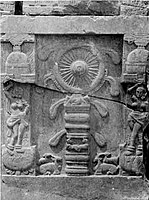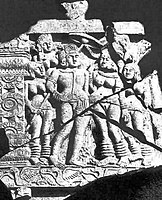History
The remains of the excavations site at Kanaganahalli can be dated to between the 1st century BC to the 3rd century AD.
In circa the 1st century BC the stupa at Kanganahalli was constructed, as per the inscriptions referred to as Hama Chaitya and it was patronized by the Hinayana and Mahayana divisions of Buddhism during the 3rd and 4th centuries AD. During the Satavahana period, the Amaravati School of art made a deep impact on the sculptural and architectural forms of Kanaganahalli region. This was indeed a period of great artistic efflorescence that gave the Maha chaitya here the most impressive form unsurpassed in the history of stupa architecture in the south India. [2]
The sculptured panels of the medhi are distinctly of native creation. The skill of making two dimensional sculptures and the carving of typical animal motifs are also of indigenous nature. Exhibit a transition phase between the early phase of Amaravati sculptural art and the elaborately sculptured panels of Nagarjunakonda with the sculptural panels found at Kanaganahalli stupa.
The volumes of their improvement over their Amaravati counterparts. The mastery of the artist of Kanganhalli in carving the geometric patterns, floral motifs, dress and ornamentation of the contemporary times and the concept of composition of the subject matter in the large sculptured panels.
The Kanaganahalli Maha Stupa is the veritable gallery of eminent rulers like King Ashoka and the Shatavahana rulers (Simuka, Pulumavi) are immortalized by depicting their portraits at Kanaganahalli.
Unlike the torana of Sanchi, Madhya Pradesh, portrait of emperor Ashoka is said to have depicted there in inscription found at Kanaganahalli.
At Kanganhalli up to the anda portion of the stupa is available, although majority of the architectural members and the sculptural panels are dislodged from the original position.

Sanchi is a Buddhist complex, famous for its Great Stupa, on a hilltop at Sanchi Town in Raisen District of the State of Madhya Pradesh, India. It is located, about 23 kilometers from Raisen town, district headquarter and 46 kilometres (29 mi) north-east of Bhopal, capital of Madhya Pradesh.
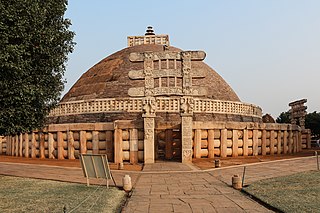
In Buddhism, a stupa is a mound-like or hemispherical structure containing relics that is used as a place of meditation.

The pillars of Ashoka are a series of monolithic columns dispersed throughout the Indian subcontinent, erected or at least inscribed with edicts by the 3rd Mauryan Emperor Ashoka The Great who reigned from c. 268 to 232 BCE. Ashoka used the expression Dhaṃma thaṃbhā, i.e. "pillars of the Dharma" to describe his own pillars. These pillars constitute important monuments of the architecture of India, most of them exhibiting the characteristic Mauryan polish. Of the pillars erected by Ashoka, twenty still survive including those with inscriptions of his edicts. Only a few with animal capitals survive of which seven complete specimens are known. Two pillars were relocated by Firuz Shah Tughlaq to Delhi. Several pillars were relocated later by Mughal Empire rulers, the animal capitals being removed. Averaging between 12 and 15 m in height, and weighing up to 50 tons each, the pillars were dragged, sometimes hundreds of miles, to where they were erected.

The Satavahanas, also referred to as the Andhras in the Puranas, were an ancient Indian dynasty based in the Deccan region. Most modern scholars believe that the Satavahana rule began in the late second century BCE and lasted until the early third century CE, although some assign the beginning of their rule to as early as the 3rd century BCE based on the Puranas, but uncorroborated by archaeological evidence. The Satavahana kingdom mainly comprised the present-day Andhra Pradesh, Telangana, and Maharashtra. At different times, their rule extended to parts of modern Gujarat, Madhya Pradesh, and Karnataka. The dynasty had different capital cities at different times, including Pratishthana (Paithan) and Amaravati (Dharanikota).
Chitapur or Chittapur is a town and taluk in Kalaburagi district in the state of Karnataka, India. It is also the headquarters of the Chittapur taluk. It is known for polished stones and toor dal.

Sculpture in the Indian subcontinent, partly because of the climate of the Indian subcontinent makes the long-term survival of organic materials difficult, essentially consists of sculpture of stone, metal or terracotta. It is clear there was a great deal of painting, and sculpture in wood and ivory, during these periods, but there are only a few survivals. The main Indian religions had all, after hesitant starts, developed the use of religious sculpture by around the start of the Common Era, and the use of stone was becoming increasingly widespread.

Nagarjunakonda is a historical town, now an island located near Nagarjuna Sagar in Palnadu district of the Indian state of Andhra Pradesh. It is one of India's richest Buddhist sites, and now lies almost entirely under the lake created by the Nagarjuna Sagar Dam. With the construction of the dam, the archaeological relics at Nagarjunakonda were submerged, and had to be excavated and transferred to higher land, which has become an island.

The Nasik Caves, or Trirashmi Leni, are a group of 23 caves carved between the 1st century BCE and the 3rd century CE, though additional sculptures were added up to about the 6th century, reflecting changes in Jainism devotional practices. The Jain sculptures are a significant group of early examples of Indian rock-cut architecture initially representing the Jainism tradition.

Simuka was an Indian king belonging to the Satavahana dynasty. He is mentioned as the first king in a list of royals in a Satavahana inscription at Nanaghat. In the Puranas, the name of the first Andhra (Satavahana) king is variously spelt as Shivmukha, Sishuka, Sindhuka, Chhismaka, Shipraka, Srimukha, etc. These are believed to be corrupted spellings of "Simuka", resulting from copying and re-copying of manuscripts.
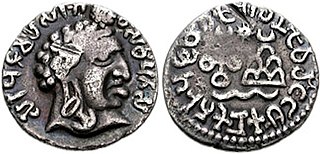
Vasishthiputra Pulumavi was a Satavahana king, and the son of Gautamiputra Satakarni. The new consensus for his reign is ca. 85-125 CE, although it was earlier dated variously: 110–138 CE or 130–159 CE. He is also referred to as Vasishthiputra Sri Pulumavi. Ptolemy, the second century writer, refers to Pulumavi as Siriptolemaios, a contemporary of the Western satrap, Chastana.
Buddhism in Northern Karnataka has seen major development after the discovery of an Ashoka inscription at Maski in Raichur District a few decades ago and of a Buddhist settlement through a series of archaeological excavations at Sannati which have shed light on the historic significance of Karnataka.
Sannati or Sannathi is a small village, located on the banks of the Bhima River in Chitapur taluk of Kalaburagi district of Northern Karnataka. It is famous for the Chandrala Parameshwari Temple and the excavations by the Archaeological Survey of India done in 1986.
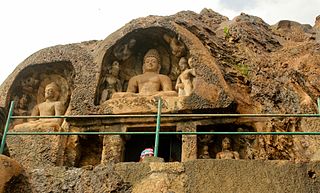
Bojjannakonda and Lingalakonda are two Buddhism rock-cut caves on adjacent hillocks, situated near a village called Sankaram, Anakapalle of ancient Kalinga. in the Indian state of Andhra Pradesh. The sites are believed to date between 4th and 9th Century A.D, when Buddhism is the majority religion of Sankaram. The original name of Bojjannakonda is Buddina Konda.
Buddhavanam is a tourism project in Nagarjuna Sagar, Telangana created by the Telangana State Tourism Development Corporation. The project was sanctioned by the Government of India viz., Integrated Development of Nagarjunasagar as part of Lower Krishna valley Buddhist circuit with a view to attract large number of domestic and foreign tourists particularly from the South-East Asian countries.
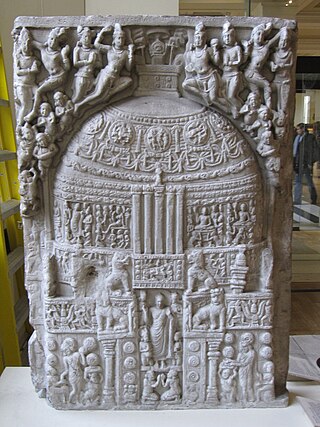
Amarāvati Stupa is a ruined Buddhist stūpa at the village of Amaravathi, Palnadu district, Andhra Pradesh, India, probably built in phases between the third century BCE and about 250 CE. It was enlarged and new sculptures replaced the earlier ones, beginning in about 50 CE. The site is under the protection of the Archaeological Survey of India, and includes the stūpa itself and the Archaeological Museum.

Chandavaram Buddhist site is an ancient Indian Buddhist site in Chandavaram village in Prakasam district in the Indian state of Andhra Pradesh. Situated on the bank of Gundlakamma River, the site is 10 kilometres (6.2 mi) northwest of Donakonda railway station. The Chandavaram Buddhist site was built between the 2nd century BCE and the 2nd century CE during the Satavahana dynasty and was discovered by Veluri Venkata Krishna Sastry in 1964.
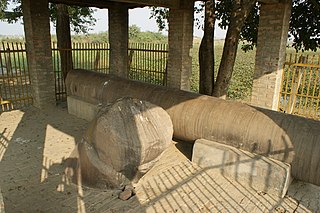
Nigali Sagar is an archaeological site in Nepal containing the remains of a pillar of Ashoka. The site is located in Nigalihawa, about 20 kilometers northwest of Lumbini and 7 kilometers northeast of Taulihawa. Another famous inscription discovered nearby in a similar context is the Lumbini pillar inscription.

Bairat Temple is a freestanding Buddhist temple, a Chaityagriha, located about a mile southwest of the city Viratnagar, Rajasthan, India, on a hill locally called "Bijak-ki-Pahari". The temple is of a circular type, formed of a central stupa surrounded by a circular colonnade and an enclosing wall. It was built during the time of Ashoka in the 3rd century BCE, and near it were found two of Ashoka's Minor Rock Edicts, the Bairat and the Calcutta-Bairat Minor Rock Edicts. It is the earliest circular Buddhist shrine and therefore, Bairat temple is an important marker of the architecture of India.

The Buddhist caves in India. Maharashtra state Aurangabad Dist. Ellora caves form an important part of Indian rock-cut architecture, and are among the most prolific examples of rock-cut architecture around the world. There are more than 1,500 known rock cut structures in India, out of which about 1000 were made by Buddhists, 300 by Hindus, and 200 by Jains. Many of these structures contain works of art of global importance, and many later caves from the Mahayana period are adorned with exquisite stone carvings. These ancient and medieval structures represent significant achievements of structural engineering and craftsmanship.

Satakarni II was the fourth of the Satavahana kings, who ruled the Deccan region of India. His reign is generally dated to 50-25 BCE.




